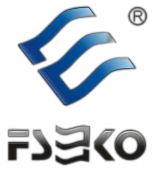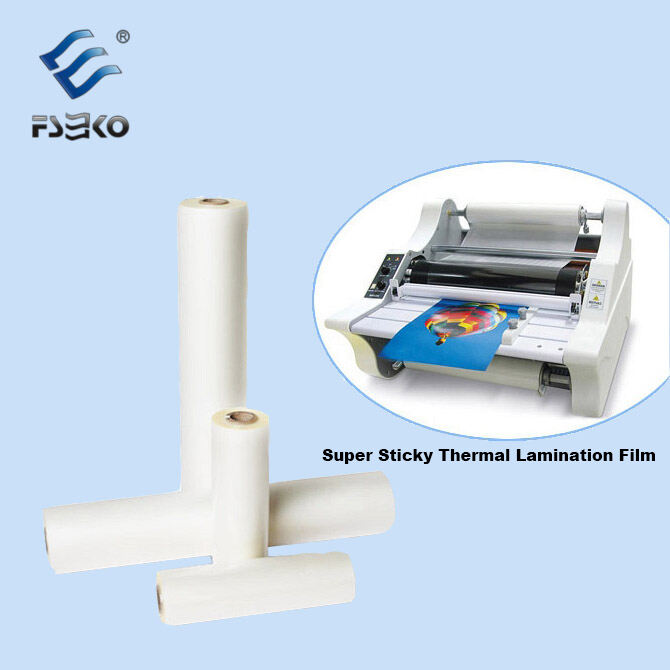நவீன அச்சிடுதலுக்கு ஏன் டிஜிட்டல்-குறிப்பிட்ட லாமினேஷன் பிலிம்கள் அவசியம்
இன்றைய டிஜிட்டல் அச்சிடும் உலகத்தில், பாரம்பரிய படங்கள் போதுமான அளவு செயல்படாததால், சிறப்பு லாமினேஷன் திரைப்படங்கள் அவசியமாகிவிட்டன. 2017-இல் நோபெலியஸ் பல்கலைக்கழகத்தின் ஆராய்ச்சியின்படி, டோனர் மூலம் அச்சிடப்பட்ட பாரம்பரிய லாமினேஷனைப் பயன்படுத்தும் அச்சிடப்பட்ட ஒவ்வொரு 10 பிரிண்டுகளில் 7 அச்சுகள் அச்சிட்ட சில வாரங்களுக்குப் பிறகு பொதிந்து குமிழிகளை உருவாக்கத் தொடங்குகின்றன. எனவேதான் தற்போது உற்பத்தியாளர்கள் செயற்கை டோனர்களுக்கென குறிப்பாக வடிவமைக்கப்பட்ட வெப்பத்தை சார்ந்த ஒட்டுகளைக் கொண்ட டிஜிட்டல் தர திரைப்படங்களை நாடுகின்றனர். இந்த புதிய திரைப்படங்கள் மை ஓட்டத்தை கெடுக்காமல் அல்லது அச்சிடும்போது நிறங்கள் தோன்றும் விதத்தை மாற்றாமல் சரியாக ஒட்டிக்கொள்கின்றன. பேக்கேஜிங் மாதிரிகள் போன்ற விலையுயர்ந்த திட்டங்களில் பணியாற்றும் வணிகங்களுக்கு இது மிகவும் முக்கியமானது. முடித்தலில் சிறிய குறைபாடுகள் கூட நேரத்தில் பெரிய இழப்புகளுக்கு வழிவகுக்கும். கடந்த ஆண்டு பொனெமன் நிறுவனம் செய்த அறிக்கையின்படி, லாமினேஷன் சரியாக செய்யப்படாததால் சில நிறுவனங்கள் ஒவ்வொரு ஆண்டும் ஏழு லட்சத்தி நாற்பதாயிரம் டாலர் கூடுதலாக செலவழிக்க நேரிடுவதாக தெரிவித்துள்ளன.
மரபுசார் மற்றும் டிஜிட்டல் (டோனர்/இன்க்ஜெட்) அச்சுகளுக்கு இடையேயான முக்கிய வேறுபாடுகள்
மரபுசார் ஆஃப்செட் அச்சுகள் பாகுத்தன்மை உள்ள பரப்புகளில் உலரும் எண்ணெய்-அடிப்படையிலான இன்க்குகளைப் பயன்படுத்துகின்றன, அதே நேரத்தில் டிஜிட்டல் டோனர் உறிஞ்சாத பாலிமர் அடுக்கை உருவாக்குகிறது. இந்த அமைப்பு வேறுபாடு குறிப்பிட்ட லாமினேஷன் முறைகளை தேவைப்படுத்துகிறது:
- அங்கீகரிப்பு தேவைகள் : ஆஃப்செட் இன்க்குகளை விட டோனரின் சொகுசான பரப்பு 20–30% அதிக செயல்படுத்தும் வெப்பநிலையை தேவைப்படுத்துகிறது.
- நீடித்த தன்மை : டிஜிட்டல் லாமினேஷன் திரைகள் அதிக உராய்வு சூழல்களில் பொதுவான மாற்றுகளை விட 40% அதிக சிராய்ப்பு எதிர்ப்பை மேம்படுத்துகின்றன.
டோனர்-அடிப்படையிலான அச்சுகள் டிஜிட்டல் லாமினேஷன் திரைகளுடன் எவ்வாறு செயல்படுகின்றன
டோனரின் தெர்மோபிளாஸ்டிக் தன்மை அதைக் கொண்டு பணியாற்றும்போது சில குறிப்பிட்ட பிரச்சினைகளை ஏற்படுத்துகிறது. செயலாக்கத்தின் போது பாரம்பரிய லாமினேஷன் படங்கள் எல்லா இடங்களிலும் சுருங்குவது வழக்கமாக இருக்கிறது, இது யாரும் பார்க்க விரும்பாத வகையில் அச்சிடப்பட்ட பிரிண்டுகள் வளைந்து போவதற்கு வழிவகுக்கிறது. இருப்பினும், டிஜிட்டல் படங்கள் இதை வேறு விதத்தில் கையாளுகின்றன; அவை 120 முதல் 140 டிகிரி செல்சியஸ் வெப்பநிலைக்கு இடையில் சூடாகும்போது டோனருடன் ஒன்றிணைந்து நகரக்கூடிய சமநிலையான பாலிமர் அடுக்குகளைக் கொண்டுள்ளன. இந்த ஒத்த விரிவாக்கம் சூரிய ஒளி மற்றும் மழை நீரால் தினமும் பாதிக்கப்படும் விளம்பரப் பலகைகள் அல்லது கார் உறைகள் போன்ற அச்சிடப்பட்ட பொருட்கள் வெளியில் எவ்வளவு காலம் நீடிக்கும் என்பதில் பெரும் வித்தியாசத்தை ஏற்படுத்துகிறது. இது போன்ற நீண்ட ஆயுள் பருவங்களின் காலநிலை தாக்குதலுக்கு இடையிலும் தங்கள் சந்தைப்படுத்தல் பொருட்கள் நன்றாக இருக்க வேண்டும் என விரும்பும் தொழில்களுக்கு மிகவும் முக்கியத்துவம் வாய்ந்ததாக இருக்கிறது.
ஒப்பொழுங்குதல் சவால்கள்: ஏன் பாரம்பரிய படங்கள் டிஜிட்டல் பிரிண்டுகளில் தோல்வியடைகின்றன
நவீன டிஜிட்டல் அச்சிடும் செயல்முறைகளின் தேவைகளைப் பூர்த்தி செய்ய ஸ்டாண்டர்ட் லாமினேட்டிங் பிளிம்கள் சிரமப்படுகின்றன, உற்பத்தியில் செலவு மிகு குறுக்குவழிகளை உருவாக்குகின்றன. இந்த ஒப்புதல்பற்றாக்குறைகளைப் புரிந்து கொள்வதன் மூலம், பொருட்களை வீணாக்காமலும், தரமான முடிவுகளை உறுதி செய்யவும் வணிகங்கள் தவிர்க்க முடியும்.
ஸ்டாண்டர்ட் பிளிம்களுக்கும் டிஜிட்டல் டோனருக்கும் இடையேயான ஒட்டுதல் பிரச்சினைகள்
டோனர்-அடிப்படையிலான டிஜிட்டல் அச்சுகள் பாரம்பரிய பிளிம்களால் வழங்க முடியாத சிறப்பு ஒட்டுதல் பண்புகளை தேவைப்படுத்துகின்றன. ஆஃப்செட் மைகளைப் போலல்லாமல், டிஜிட்டல் டோனர் அடிப்படைப் பொருளின் மேற்பரப்பில் படிகிறது, அதில் ஊடுருவுவதில்லை. ஸ்டாண்டர்ட் பிளிம்கள் இந்த அடுக்கப்பட்ட டோனருடன் வேதியியல் பிணைப்பை ஏற்படுத்த முடியாது என்பதை ஆராய்ச்சி காட்டுகிறது, இதன் விளைவாக:
- குமிழ்கள் பயன்பாட்டிற்குப் பிறகு 72 மணி நேரத்திற்குள்
- ஓர உயர்வு ஒட்டுதல் செயல்பாட்டில் ஏற்படும் ஒருமையற்ற தன்மை காரணமாக
- பிரித்தெடுத்தல் இலேசான உராய்வு அல்லது வெப்பநிலை மாற்றங்களுக்கு உட்பட்டு
| அடிப்படை | ஸ்டாண்டர்ட் திரைப்படங்கள் | டிஜிட்டல் லாமினேஷன் பிளிம்கள் |
|---|---|---|
| டோனருடன் ஒட்டுதல் | மோசமான பிணைப்பு | மூலக்கூறு அளவில் பிடிப்பு |
| அறிவு சார்ந்து | 230°F இல் வளைகிறது | 300°F வரை நிலையானது |
| பணிப்பாய்வு ஒப்பொழுங்குதல் | கையால் சரிசெய்தல் தேவை | இலக்க அச்சு அமைப்புகளுடன் பொருந்துகிறது |
இலக்க அச்சிடுதல் வெளியீடுகளுடன் ஒப்பொழுங்குதலை உறுதி செய்தல்
இலக்க லாமினேஷன் திரைகள் லேசர் அச்சிடப்பட்ட அல்லது மைஜெட் பொருட்களின் தனித்துவமான பரப்பு ஆற்றல் மட்டங்களுக்கு ஈடுகொடுக்கின்றன. அவற்றின் மாற்றப்பட்ட ஒட்டுகள் குறைந்த வெப்பநிலையில் (மரபுவழி திரைகளுக்கான 250°F-க்கு எதிராக 180–210°F) செயல்படுத்தப்படுகின்றன, பயன்பாட்டின் போது டோனர் உருகுவதைத் தடுக்கின்றன. இது அதிக அடர்த்தி கொண்ட கிராபிக்ஸ், நிழல்-அதிகமான வடிவமைப்புகள் மற்றும் உலோகம் அல்லது ஃபுளூரோசென்ட் நிற அடுக்குகளில் உள்ள நுண்ணிய விவரங்களைப் பாதுகாக்கிறது.
இலக்க பணிப்பாய்வுகளில் இலக்க லாமினேஷன் திரையின் தொடர்ச்சியான ஒருங்கிணைப்பு
நவீன டிஜிட்டல் திரைப்படங்கள் JDF-உடன்பாடுள்ள ரோல் வடிவங்களுடன், தவறான ஊட்டுதலைத் தடுக்கும் ஸ்டாடிக்-எதிர்ப்பு லைனர்களுடன், 15 வினாடிகளுக்குள் இன்லைன் டை-வெட்டுதலை அனுமதிக்கும் உடனடி சிகிச்சையுடன் டிஜிட்டல் பதிப்புகளின் திறமைத்துவத்தை எதிரொலிக்கின்றன. ஒட்டுதல் அறிவியல், பொருள் ஒப்புத்தகுதி மற்றும் செயல்முறை ஒழுங்கமைவை கவனத்தில் கொள்வதன் மூலம், டிஜிட்டல் லாமினேஷன் திரைப்படங்கள் பாரம்பரிய திரைப்படங்களால் ஏற்படும் 27% மறுபணியை நீக்குகின்றன (நோபெலஸ் பல்கலைக்கழகம் 2017).
B2B காட்சி தொடர்புகளில் டிஜிட்டல் லாமினேஷன் திரைப்படத்தின் முக்கிய பயன்பாடுகள்
சைனேஜ், வாகன மூடுதல்கள், டீகல்கள் மற்றும் புத்தக மூடுகள்
கடுமையான சூழல்களுக்கு வெளிப்படுத்தப்பட்டாலும் பிராண்ட் தெரிவுதன்மையை பாதுகாக்க உதவும் டிஜிட்டல் அச்சிடுதலுக்கான லாமினேஷன் பில்ம்கள். FLEXcon-இன் 2024 தரவுகளின்படி, வாகன கிராபிக்ஸ்களில் நிறங்கள் மூன்று முதல் ஏழு ஆண்டுகள் வரை புதிதாக இருக்க UV எதிர்ப்பு BOPP பில்ம்களை எடுத்துக்காட்டாக எடுத்துக்கொள்ளலாம். பிரகாசமான சூரிய ஒளியில் தெளிவாக படிக்க வேண்டிய சிக்னுகளில் தேவையற்ற ஒளிர்வைக் குறைப்பதற்கு உதவும் உரோக்கிய விருப்பங்களும் கையமைதியாக இருக்கின்றன. வாகனங்களை சுற்றும்போது, சரியான ஒட்டுதலைத் தேர்வு செய்வது மிகப்பெரிய வித்தியாசத்தை ஏற்படுத்தும். சாதாரண பொருட்கள் நேரத்தில் பிரிந்துவிடும் கடினமான வளைந்த மேற்பரப்புகளில் ஓரங்கள் மிக நன்றாக இடத்தில் நிலைத்திருக்கும். புத்தக மூடிகளுக்கு, பாலியஸ்டர் அடிப்படையிலான பில்ம்கள் அழிவு மற்றும் தேய்மானத்திற்கு எதிராக தீவிர பாதுகாப்பை வழங்குகின்றன. அடிக்கடி கையாளப்படும் அல்லது சரியான நிலைமைகளுக்கு அப்பாற்பட்டு சேமிக்கப்படும் புத்தகங்களுக்கு ஏற்றதாக, சாதாரண காகித மூடிகளை விட இருமடங்கு நன்றாக உராய்வு மற்றும் சிராய்ப்புகளுக்கு எதிராக தாங்கும்.
ஆடம்பரம் மற்றும் கார்ட்டன் பேக்கேஜிங் அலங்காரம்
மேட்-முடித்த டிஜிட்டல் லாமினேஷன் திரைப்படங்கள் அழகுசாதனப் பெட்டிகளுக்கு தொடு ஆழத்தைச் சேர்ப்பதன் மூலம் பேக்கேஜிங் அனுபவத்தை உயர்த்துகின்றன—72% ஐசிய வாங்குபவர்கள் மென்மையான தொடு உருவாக்கங்களை உயர்தர தரத்துடன் தொடர்புபடுத்துகின்றனர் ( பேக்கேஜிங் போக்குகள் அறிக்கை ). ஃபாயில்-அச்சிடப்பட்ட பெட்டிகள் சில்லறை கையாளுதலின் போது கைரேகைகளைத் தடுக்கும் அழுக்கு-எதிர்ப்பு லாமினேட்களுடன் இணைக்கப்பட்டுள்ளன.
சிறப்பு லாமினேட்களைப் பயன்படுத்தி தனிப்பயன் பிராண்டிங் தீர்வுகள்
சிறப்பு தொகுப்பு கட்டுமானத்திற்காக ஹோலோகிராபிக் திரைப்படங்களை நிறுவனங்கள் பயன்படுத்துகின்றன, ஏனெனில் அவை கடை அலமாரிகளில் மிகவும் தனித்துவமாக தோன்றுகின்றன. சில ஆய்வுகள் இந்த கண்ணைக் கவரும் வடிவமைப்புகள் காட்சி தெரிவுதன்மையை சுமார் 60% வரை அதிகரிக்க முடியும் என்று காட்டுகின்றன. செயற்கை பொருட்களில் அழகான லோகோக்களை பொருத்துவதில், வெப்பத்தால் செயல்படும் ஒட்டுப்பொருட்கள் சிறப்பாக செயல்படுகின்றன. இது முழு கட்டுமானத்தை மறுசுழற்சி செய்ய முடியாததாக ஆக்காமலேயே உற்பத்தியாளர்கள் அழகான 3D விளைவுகளை உருவாக்க உதவுகிறது. பின்னர் UV உணர்திறன் பிரச்சினை உள்ளது. வெளிப்புற பதாகைகள் சூரிய ஒளியால் ஏற்படும் சேதத்திலிருந்து பாதுகாப்பு தேவைப்படுவதால், நிறுவனங்கள் UV எதிர்ப்பு டிஜிட்டல் படலமிடும் திரைப்படங்களைப் பயன்படுத்துகின்றன. இந்த திரைப்படங்கள் UVA மற்றும் UVB கதிர்களில் சுமார் 99% வரை தடுக்கின்றன, ஆனாலும் நீண்ட காலத்திற்கு நிறங்கள் உண்மையானவையாகவும், தீவிரமாகவும் தோன்றுவதை உறுதி செய்கின்றன.
சிறப்பு முடிப்புகள் மூலம் அழகியல் மற்றும் தொடு மேம்பாடு
பளபளப்பு, மங்கலான, பட்டு மற்றும் மென்மையான-தொடு முடிப்புகள் மூலம் வடிவமைப்பை உயர்த்துதல்
மேற்பரப்பு முடிப்புகளுடன் சாதாரண அச்சுகளை மக்கள் உண்மையில் உணரவும், அனுபவிக்கவும் கூடிய வகையில் மாற்றும் பல்வேறு கிரியேட்டிவ் வாய்ப்புகளை டிஜிட்டல் லாமினேஷன் திரைப்படம் திறக்கிறது. நிறங்களை உண்மையிலேயே வெளிப்படையாக்கும் பளபளப்பான திரைப்படங்கள், கவனத்தை ஈர்க்கும் சமிக்ஞைகள் மற்றும் போஸ்டர்களுக்கு ஏற்றதாக இருப்பதால் பிரபலமாக உள்ளன. எதிரொலிப்புகளைக் குறைப்பதில் மாட்டே முடிப்புகள் சிறந்தவை, எனவே கலை கேலரிகளில் உள்ள தூய்மையான, நவீன காட்சி ஏற்பாடுகளுக்கு இவை பொருத்தமானவை. பிரபுத்துவ கட்டுமான வடிவமைப்புகளுக்கு ஒரு தொடுதல் வகையைச் சேர்க்கும் பட்டு உருவாக்கங்களும் உள்ளன, மேலும் யாராவது தங்கள் விரல்களை ஓட்டும்போது தயாரிப்புகளுக்கு மென்மையான, கிட்டத்தட்ட வெல்வெட் போன்ற உணர்வை அளிக்கும் மென்தொடு பூச்சுகளும் உள்ளன. குறிப்பாக இதுபோன்ற சிகிச்சைகளிலிருந்து பயனடையும் பதிவுகள். இந்த வெவ்வேறு முடிப்புகளை மதிப்புமிக்கதாக ஆக்குவது நன்றாக இருப்பது மட்டுமல்ல. இவை பல்வேறு பிராண்டுகள் நிலைநிறுத்தும் விஷயங்களுடன் உண்மையில் பொருந்துகின்றன. குறைப்பாளர் நிறுவனங்கள் பொதுவாக மாட்டே மேற்பரப்புகளைத் தேர்வு செய்கின்றன, தைரியமான பிராண்டுகள் பளபளப்பின் பிரகாசத்தை விரும்புகின்றன, மேலும் உயர்தரமாக நிலைநிறுத்தப்பட்டுள்ள எதுவாக இருந்தாலும் பொதுவாக அந்த சிறப்பு மென்தொடு முடிப்பைப் பெறுகிறது.
பிராண்ட் தாக்கத்திற்கான எம்பாஸ், உலோக, ஹோலோகிராபிக் மற்றும் கிளிட்டர் விளைவுகள்
உயர்த்தப்பட்ட அமைப்புகள் அல்லது ஹோலோகிராபிக் திரைப்படங்கள் போன்ற சிறப்பு விளைவுகளைச் சேர்ப்பது அச்சிடப்பட்ட பொருட்களுக்கு சாதாரண காகிதத்தால் எட்ட முடியாத கூடுதல் பரிமாணத்தை வழங்குகிறது. புத்தகங்கள் உயர்த்தப்பட்ட லோகோக்களை உயர்த்துதல் நுட்பங்கள் மூலம் பெறும்போது, அது மூடியை தொடுவது போன்ற உணர்வை ஏற்படுத்துகிறது. இதேபோல, சில மின்னணு கருவிகள் பிரஷ் செய்யப்பட்ட உலோகத்தைப் போலத் தோன்றுவதற்காக சிறப்பு உலோகப் பூச்சுகளால் சுற்றப்பட்டிருக்கும். குறிப்பிட்ட கால பதிப்பு தயாரிப்புகளுக்கு, பல்வேறு கோணங்களில் இருந்து பார்க்கும்போது மாறும் கண்கவர் வடிவங்களை உருவாக்கும் ஹோலோகிராபிக் திரைப்படங்களை தயாரிப்பாளர்கள் அடிக்கடி பயன்படுத்துகின்றனர். அழகுசாதனப் பாட்டில்கள் பெரும்பாலும் கிளிட்டர் கலந்த லேமினேட்டுகளையும் கொண்டுள்ளன, இது பல வாங்குபவர்களை ஈர்க்கக்கூடிய மின்னும் முடித்த தோற்றத்தை அவற்றுக்கு வழங்குகிறது. பேக்கேஜிங் டைஜஸ்ட் (2024) நடத்திய சமீபத்திய ஆய்வின் படி, இதுபோன்ற காட்சி மேம்பாடுகளை நான்கில் மூன்று பங்கு நுகர்வோர் உயர்தர பொருட்களுடன் தொடர்புபடுத்துகின்றனர். இதுதான் அவர்கள் செயல்படும் போட்டித்தன்மை வாய்ந்த சந்தைச் சூழலுக்கு இருந்தபோதிலும் பல ஐசு பிராண்டுகள் இந்த விளைவுகளில் கனிவாக முதலீடு செய்வதற்கான காரணம்.
உருவத்தையும் முடித்தலையும் பயன்படுத்தி வாடிக்கையாளர் ஈடுபாட்டை ஊக்குவித்தல்
மக்கள் ஏதாவது வாங்க முடிவு செய்யும்போது, அதன் தொடுதல் உணர்வு மிகவும் முக்கியமானது. கடந்த ஆண்டு Packaging Digest-இன் கூற்றுப்படி, சுமார் ஆறு பத்தில் ஐந்து பங்கு வாங்குபவர்கள் தொடுவதற்கு உண்மையாக உணரக்கூடிய பொதிகளை தொடுவதில் அதிக நேரத்தை செலவிடுகின்றனர். மென்மையான பூச்சு பூசப்பட்ட அழகுசாதனப் பெட்டிகள் அதிக நேரம் கையாளப்படுகின்றன, மேலும் எம்பாஸ் செய்யப்பட்ட தொழில்துறை அடையாள அட்டைகள் ஏதோ ஒன்றை தொழில்நுட்ப ரீதியாக தோற்றமளிக்கின்றன. பளபளப்பான புள்ளிகள் கொண்ட தயாரிப்பு லேபிள்கள் முக்கியமானவற்றை உடனடியாக கவனத்தை ஈர்க்கின்றன, அதே நேரத்தில் கொஞ்சம் கடினமான உருவத்துடன் கூடிய ஹேங் டேக்குகள் பிராண்ட் சுற்றுச்சூழலை பாதுகாக்க கவனம் செலுத்துகிறது என்று வாடிக்கையாளர்கள் நினைக்க வைக்கின்றன. நிறுவனங்கள் அவை அடைய விரும்புவதைப் பொறுத்து முடித்தல் தேர்வுகளை பொருத்தும்போது, பளபளப்பு உடனடி தேவையை உருவாக்குகிறது, மாட்டே மேற்பரப்புகள் நம்பிக்கையை உருவாக்குகின்றன, மேலும் வெவ்வேறு உருவங்கள் நினைவில் நிலைத்திருக்கின்றன; இதன் மூலம் நிறுவனங்கள் சாதாரண அச்சிடப்பட்ட பொருட்களை ஒரே நேரத்தில் பல உணர்வுகளை ஈடுபடுத்தும் அனுபவங்களாக மாற்றுகின்றன.
நீண்ட கால முடிவுகளுக்கான உறுதித்தன்மை, பாதுகாப்பு மற்றும் பொருள் தேர்வு
டிஜிட்டல் லாமினேஷனுக்கான BOPP, PVC மற்றும் PET ஆகியவற்றை படல பொருட்களுடன் ஒப்பிடுதல்
இருதலைச் சீரமைக்கப்பட்ட பாலிபுரோப்பிலீன் (BOPP) திரைகள் உயர்ந்த தெளிவையும், ஈரப்பதத்தை எதிர்க்கும் தன்மையையும் வழங்கி, சில்லறை விற்பனை கட்டுமானத்திற்கு ஏற்றவை. அடையாள அட்டைகள் போன்ற கடினமான பயன்பாடுகளுக்கு பாலிவினைல் குளோரைடு (PVC) உயர் இழுவிசை வலிமையை வழங்குகிறது, அதே நேரத்தில் PET திரைகள் அதிக பாதசாரி பகுதிகளில் உள்ள சாய்வுகளுக்கு சிராய்ப்பை எதிர்க்கும் தன்மையில் சிறந்தவை.
ஒட்டும் பொருட்களின் வகைகள்: குளிர், வெப்ப-உதவி மற்றும் வெப்ப செயல்பாடு – விளக்கம்
அறை வெப்பநிலையில் குளிர் ஒட்டும் பொருட்கள் இணைக்கப்படுகின்றன, இது நுண்ணிய டிஜிட்டல் மைகளைப் பாதுகாக்கிறது. பரப்பு உருவமைப்புகளுக்கு 120–140°F சூடேற்றம் தேவைப்படும் வெப்ப-உதவி ஒட்டும் பொருட்கள், மற்றும் வெப்ப ஒட்டும் பொருட்கள் (220°F+) ஆட்டோமொபைல் மூடுதல்களுக்கு நிரந்தர இணைப்பை உருவாக்குகின்றன.
UV எதிர்ப்பு, வெளிப்புற நீடித்தன்மை மற்றும் அச்சிடப்பட்ட ஆயுளை நீட்டித்தல்
2024 மேம்பட்ட பொருள் செயல்திறன் ஆய்வு, UV தடுப்பான்களைக் கொண்ட திரைகள் வெளிப்புற காட்சிகளில் 92% நிறம் மங்குதலைத் தடுக்கின்றன என்று கண்டறிந்துள்ளது. கட்டிடங்களில் நேரடி சூரிய ஒளியில் வெளிப்புறமாக வைக்கப்படும் மூடுதல்களுக்கு முக்கியமான 5 ஆண்டுகள் காலநிலை சோதனைகளில் PET திரைகள் PVC ஐ விட 40% சிறந்து விளங்குகின்றன.
அச்சிடப்பட்டவைகளை உராய்வு, ஈரப்பதம் மற்றும் சுற்றுச்சூழல் சேதத்திலிருந்து பாதுகாத்தல்
BOPP திரைகள் லாமினேட் செய்யப்படாத பரப்புகளை விட கார்ட்டன் பேக்கேஜிங்கில் உரசல் குறிகளை 78% குறைக்கின்றன. நீர்-அடிப்படையிலான ஒட்டுகள் ஈரப்பதமான சூழலில் ஓரங்கள் தூக்குவதைத் தடுத்து, தொழில்துறை சூழல்களில் லேபிள்களின் ஆயுட்காலத்தை 3–5 ஆண்டுகள் நீட்டிக்கின்றன.
தேவையான கேள்விகள்
டிஜிட்டல்-குறிப்பிட்ட லாமினேஷன் திரைகள் ஏன் அவசியம்?
இணக்கமின்மை காரணமாக டிஜிட்டல் அச்சிடுதலுடன் பயன்படுத்தும்போது சாதாரண லாமினேஷன் திரைகள் பொதுவாக பொத்துகளாகவும், பொத்திக்கொண்டும் இருக்கும். டிஜிட்டல்-குறிப்பிட்ட திரைகள் செயற்கை டோனர்களுக்கு ஏற்ற ஒட்டுகளைக் கொண்டுள்ளன, இது சிறந்த ஒட்டுதலையும், நீண்ட கால முடிவுகளையும் உறுதி செய்கிறது.
டிஜிட்டல் அச்சிடுதலில் பாரம்பரிய திரைகள் என்ன பிரச்சினைகளை எதிர்கொள்கின்றன?
பொதுவாக பாரம்பரிய திரைகள் பல்வேறு சூழ்நிலைகளில் பொத்துதல், ஓரங்கள் தூக்குதல் மற்றும் பொத்திக்கொள்வதற்கு வழிவகுக்கும் ஒட்டுதலில் சிரமங்களை எதிர்கொள்கின்றன. அவை டிஜிட்டல் லாமினேஷன் திரைகளை விட குறைந்த வெப்பநிலையில் வளைவதும் உண்டு.
டிஜிட்டல் அச்சிடுதலில் சிறப்பு முடிப்புகளின் நன்மைகள் என்ன?
அச்சிடப்பட்ட பொருட்களின் தோற்றம் மற்றும் தொடுதல் உணர்வை மேம்படுத்தவும், பிராண்ட் மதிப்புகளுடன் ஒத்திருக்கவும், வாடிக்கையாளர் உணர்வுகள் மற்றும் ஈடுபாட்டை மேம்படுத்தவும் பளபளப்பு, மட்டையான, பட்டு, மென்மையான தொடுதல் போன்ற சிறப்பு முடித்தல்கள் உதவுகின்றன.
BOPP, PVC மற்றும் PET திரைகளுக்கு இடையே உள்ள வித்தியாசம் என்ன?
BOPP திரைகள் தெளிவுத்துவம் மற்றும் ஈரப்பத எதிர்ப்பை வழங்குகின்றன, PVC திரைகள் கடினமான பயன்பாடுகளுக்கு இழுவிசை வலிமையை வழங்குகின்றன, அதேசமயம் PET திரைகள் அதிக பாவனை உள்ள பகுதிகளுக்கு கீறல் எதிர்ப்பில் சிறந்தவை.
UV-எதிர்ப்பு லாமினேஷன் திரைகள் வெளிப்புற அச்சிடுதல்களுக்கு எவ்வாறு பயனளிக்கின்றன?
UV-எதிர்ப்பு திரைகள் UVA மற்றும் UVB கதிர்களில் பெரும்பகுதியை தடுக்கின்றன, நிறம் மங்குதல் மற்றும் சூரிய ஒளியின் வெளிப்பாட்டால் ஏற்படும் சேதத்தை தடுப்பதன் மூலம் வெளிப்புற அச்சிடுதல்களின் நிற நேர்மையை பாதுகாத்து, அவற்றின் ஆயுட்காலத்தை நீட்டிக்கின்றன.
உள்ளடக்கப் பட்டியல்
- நவீன அச்சிடுதலுக்கு ஏன் டிஜிட்டல்-குறிப்பிட்ட லாமினேஷன் பிலிம்கள் அவசியம்
- மரபுசார் மற்றும் டிஜிட்டல் (டோனர்/இன்க்ஜெட்) அச்சுகளுக்கு இடையேயான முக்கிய வேறுபாடுகள்
- டோனர்-அடிப்படையிலான அச்சுகள் டிஜிட்டல் லாமினேஷன் திரைகளுடன் எவ்வாறு செயல்படுகின்றன
- ஒப்பொழுங்குதல் சவால்கள்: ஏன் பாரம்பரிய படங்கள் டிஜிட்டல் பிரிண்டுகளில் தோல்வியடைகின்றன
- B2B காட்சி தொடர்புகளில் டிஜிட்டல் லாமினேஷன் திரைப்படத்தின் முக்கிய பயன்பாடுகள்
- சிறப்பு முடிப்புகள் மூலம் அழகியல் மற்றும் தொடு மேம்பாடு
-
நீண்ட கால முடிவுகளுக்கான உறுதித்தன்மை, பாதுகாப்பு மற்றும் பொருள் தேர்வு
- டிஜிட்டல் லாமினேஷனுக்கான BOPP, PVC மற்றும் PET ஆகியவற்றை படல பொருட்களுடன் ஒப்பிடுதல்
- ஒட்டும் பொருட்களின் வகைகள்: குளிர், வெப்ப-உதவி மற்றும் வெப்ப செயல்பாடு – விளக்கம்
- UV எதிர்ப்பு, வெளிப்புற நீடித்தன்மை மற்றும் அச்சிடப்பட்ட ஆயுளை நீட்டித்தல்
- அச்சிடப்பட்டவைகளை உராய்வு, ஈரப்பதம் மற்றும் சுற்றுச்சூழல் சேதத்திலிருந்து பாதுகாத்தல்
-
தேவையான கேள்விகள்
- டிஜிட்டல்-குறிப்பிட்ட லாமினேஷன் திரைகள் ஏன் அவசியம்?
- டிஜிட்டல் அச்சிடுதலில் பாரம்பரிய திரைகள் என்ன பிரச்சினைகளை எதிர்கொள்கின்றன?
- டிஜிட்டல் அச்சிடுதலில் சிறப்பு முடிப்புகளின் நன்மைகள் என்ன?
- BOPP, PVC மற்றும் PET திரைகளுக்கு இடையே உள்ள வித்தியாசம் என்ன?
- UV-எதிர்ப்பு லாமினேஷன் திரைகள் வெளிப்புற அச்சிடுதல்களுக்கு எவ்வாறு பயனளிக்கின்றன?


